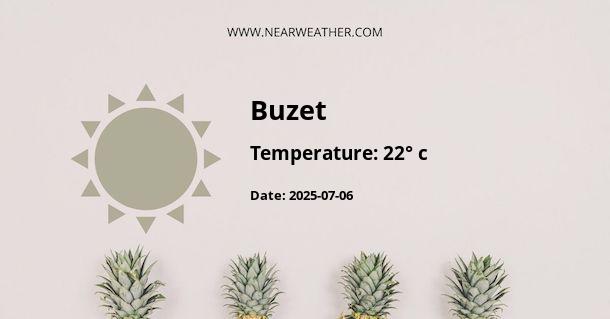Introduction to Buzet and Its Climate
Buzet, a picturesque town situated in the northern part of the Istrian peninsula in Croatia, holds a charm that is enhanced by its diverse climate. Often referred to as the "City of Truffles," Buzet is not only rich in culinary treasures but also in its weather patterns. Understanding the nuances of Buzet's climate is essential for anyone looking to visit or study this unique location. With its Mediterranean and continental climate influences, there is much to discuss regarding the weather in Buzet year-round.
Geographical Influence on Buzet's Climate
The climate of Buzet is heavily influenced by its geographical location. Nestled between the Učka mountain range to the west and the continental hinterland to the east, Buzet experiences a blend of Mediterranean and Continental climates. The proximity to the Adriatic Sea also plays a significant role in shaping the weather patterns, bringing mild winters and warm summers to the region.
Seasonal Weather Patterns in Buzet
The seasonal variations in Buzet’s climate can be dissected to highlight the unique characteristics that each part of the year brings to the region:
Spring
Spring in Buzet typically starts in March and stretches through May. This period sees a gradual increase in temperatures and day lengths. Precipitation during spring fluctuates, with occasional showers that help in the blooming of the area's natural flora.
Summer
Summer spans from June to August, ushering in warm temperatures and a high influx of tourists drawn by the pleasant Mediterranean climate. The average high temperatures in the peak of summer can reach above 30°C (86°F).
Autumn
Autumn, covering September to November, is a period of transition. The temperatures begin to cool, and the lush green landscapes start to take on a golden hue. This is also the season when Buzet's famous truffles are in abundance, aligning with the region's gastronomic celebrations.
Winter
Winter in Buzet, spanning December through February, brings cooler temperatures and a higher chance of precipitation, including occasional snowfalls, owing to its continental influence. However, the temperatures seldom plummet to extreme cold due to the mitigating effects of the nearby Adriatic Sea.
Monthly Climate Details of Buzet
| Month | Average High (°C) | Average Low (°C) | Precipitation (mm) |
|---|---|---|---|
| January | 6.4 | -1.3 | 78.1 |
| February | 8.1 | 0.1 | 70.0 |
| March | 12.2 | 3.6 | 80.8 |
| April | 16.5 | 7.3 | 88.0 |
| May | 21.7 | 11.8 | 72.5 |
| June | 25.2 | 15.3 | 89.3 |
| July | 28.1 | 17.6 | 63.6 |
| August | 27.9 | 17.4 | 89.9 |
| September | 23.7 | 14.0 | 101.5 |
| October | 18.3 | 10.1 | 128.2 |
| November | 12.5 | 5.4 | 137.9 |
| December | 7.6 | 0.8 | 109.8 |
Understanding the Humidity and Wind Influence
The humidity in Buzet is typically higher during the end of autumn and winter months due to the increase in precipitation. This higher humidity can amplify the perceived coldness during the winter season. In contrast, summer months enjoy a drier climate, making the warm temperatures more comfortable. The bura, a northeasterly wind, frequently affects the region, particularly in the winter, bringing cool and dry air from the continent. The sirocco, a southeastern wind, often carries moist and warm air from the sea, which can lead to increased humidity and higher temperatures.
Extreme Weather Events and Climate Change Impact
Buzet is an area that is susceptible to the influences of climate change, with changes in precipitation patterns and an increase in the frequency of extreme weather events being noted by climatologists. Flooding and heatwaves are becoming more common, impacting agriculture, the ecosystem, and daily life. Adaptation strategies and local policies are being developed in response to these changing conditions.
Tourism and Best Times to Visit Buzet Based on Climate
The best time to visit Buzet depends largely on the activities you are interested in. For beach-goers and those seeking to experience the warm Mediterranean climate, the months of June through September are ideal. However, those looking to partake in truffle hunting and to enjoy the autumn landscapes and festivals may find September and October to be the most rewarding. The spring, from April to May, offers mild weather perfect for outdoor activities and exploring the Istrian countryside without the peak season crowds.
Preparation Tips for Travelers to Buzet
- Spring visitors should pack layers and a waterproof jacket to accommodate fluctuating temperatures and possible rain.
- Summer tourists should bring sunscreen, hats, and light clothing to deal with the strong sun and high temperatures.
- Autumn travelers will benefit from waterproof footwear and comfortable layers to adapt to the cooler days and potential rainfall.
- Winter tourists should prepare for colder weather with warm clothing, thermal layers, and possibly snow gear, depending on the expected snowfall.
Final Thoughts on Buzet's Climatic Charm
With its seasonal variations, influenced by both Mediterranean and continental climates, Buzet presents a rich tapestry of weather conditions throughout the year. Each season bestows its own beauty and optimal conditions for different activities. Recognizing the trends and specifics of Buzet's weather is not only vital for those planning a visit but also contributes to a deeper appreciation of the unique climatic identity of this Istrian gem.
A - Buzet's Latitude is 45.409439 & Longitude is 13.966670.
A - Weather in Buzet is 10° today.
A - Climate Conditions in Buzet shows overcast clouds today.
A - Humidity in Buzet is 88% today.
A - Wind speed in Buzet is 4.43 km/h, flowing at 119° wind direction. today.
